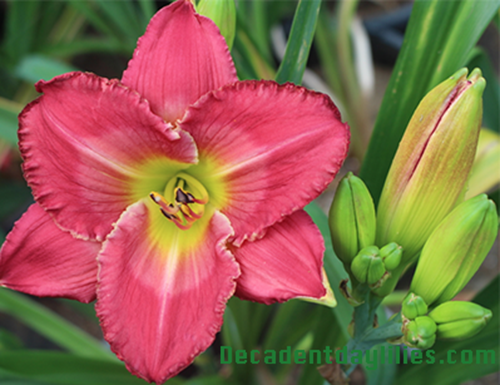How to Grow Daylilies

Daylilies are herbaceous perennial plants and will flower between October to December in Australia. In mild climates and depending on the variety (cultivar) daylilies can flower spasmodically all year round. They can be planted any time of the year but if planted out in summer grow them in a pot first so that they can be protected from the harsh summer sun until they get established.
Your daylilies will arrive bare-rooted. When they arrive trim the leaves about 1-2 inches.
Soak the plants for several hours or overnight in water or in a weak solution of seaweed emulsion i.e. Seasol with just enough water to cover the roots. This enables the roots to rehydrate. Try to plant out your daylilies as soon as you can as they are a perennial plant and don’t like being left to dry out completely or left soaking in water.
Daylilies should be planted 12 to 24 inches apart allowing room for air movement and growth. Your new daylily looks tiny but in a couple of years it will easily fill that area. Of course some daylilies are more vigorous than others.
Take note when planting of the height scape and flower size as this is a good indication of how large the plant will grow. You do not want to overcrowd or shadow small sized daylilies. A minimum of 6 hours of direct sunlight is required to produce good flowering. Light shade during the hottest part of the day keeps the flowers fresh. Daylilies should not be planted near trees and shrubs that are likely to compete for moisture and nutrients.
Prepare the garden bed by toiling over the soil and adding organic matter such as manures and composts. A light application of blood and bone can also be added at this time. Organic is preferable, a little bit more often is best. Do not overfertilise, especially when the plants are new.
The planting hole should be twice the size of the roots of the plant. Create a mound to place the roots on. Do not plant too deep; the crown should be only covered with one inch of soil. Planting too deep can inhibit flowering. Avoid high nitrogen fertilisers as they will produce plenty of new leaf growth at the expense of the flowers.
Although daylilies are adaptable to most soils, they do best in a slightly acidic, moist soil that is high in organic matter and well drained. Ideal soil pH is 6.5.
Two inches of water a couple of times a week should be sufficient for your daylilies to get established relative to weather conditions and the type of soil that you have. Do not overwater as that can lead to rot. A personal recommendation is not to add mulch until the daylilies have been established and then don’t place the mulch too close to the crown of the plant.
Daylilies are drought hardy but will need water to get established and develop a good root system. New foliage will start to emerge from the centre and the old outside foliage will brown and die off. This is a normal occurrence and this happens throughout the growing season as new leaves are constantly formed. Remove unwanted seed pods as this weakens the plant.
Some varieties are evergreen, semi-evergreen and dormant. Remember to make a note of where you plant the dormant varieties so that you know not to dig it up and worry that they may have died. Depending on the level of frost in the area where you live some semi-evergreens can become dormant.
Daylilies are a tough rewarding perennial plant and once established will tolerate neglect and drought but if you feed and water well then you will get more enjoyment out of your daylilies. To ensure good rebloom daylilies will need some extra watering once the first lot of scapes are forming, this ensures that the plant keeps growing whilst flowering as flowering uses a lot of the plant's energy. Some variety of daylilies rebloom constantly some rebloom six weeks later. This too can vary from area to area and soil types.
In spring add some organic matter such as dynamic lifter, blood and bone, manure or compost to the soil to boost growth. I also add some sulphate of potash (not muriate of potash) every couple of months as this assists flowering and promotes plant protection against diseases and insect attacks.
Daylilies will need to be divided every 4 to 5 years, depending on the vigour of the particular variety. Overcrowding leads to less productive flowering.
A number of pests can attack daylilies, such as thrip, aphids, spider mite and snails. Generally they are not serious enough to warrant treatment but if they are in plague proportions then action should be taken as they can weaken and stress the plant. A good organic insecticide is OCP’s Eco-oil.
